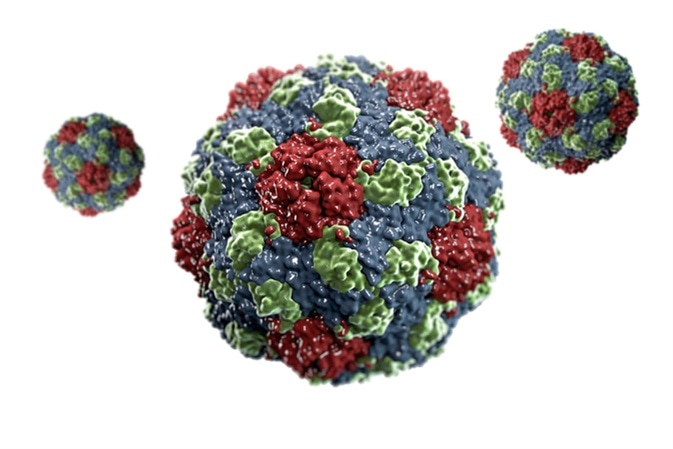Parechoviruses that are of two different types, Parechovirus A and Parechovirus B, are a genre of small, non-enveloped, single-stranded, positive sense RNA virus under the family Picornaviridae. Of the two types, Parechovirus A is a human pathogen (thus called human parechovirus), while parechovirus B infects animals.
The human parechovirus (HPeV) can affect people of all age groups, however, small children who are in their first few days of life are seen to be the most affected. Nineteen different types of human parechoviruses have been discovered by researchers, which range from HPeV 1–19. Among these types, HPeV 1 and 3 are the most common and frequent human pathogens.
These viruses get transmitted from one person to another through the direct or indirect contact with respiratory droplets, saliva, or feces of an infected person. Although the virus is not confirmed to be teratogenic, there is evidence that shows the utero transmission from mother to child.

The Structure of Human Parechovirus. Parechoviruses are human pathogens that cause diseases ranging from gastrointestinal disorders to encephalitis. - Image Credit: vitstudio / Shutterstock
General Symptoms of Parechovirus A
Human parechoviruses are not known to exhibit any symptoms (especially HPeV 1, which is purely asymptomatic in nature). In some cases, a mild diarrheal illness or respiratory infection is seen. Other common symptoms are fever, cold, or flu-like conditions.
Severe infection with physical and mental stress or strain can lead to more intense blood infections and neurological infections such as sepsis, meningitis, and encephalitis.
Most of the symptoms, if exhibited, or the diseases caused due to the infection of this virus are similar to the symptoms caused by the infection of enterovirus. They are distinguishable only after laboratory separation and analysis of the virus.
Many diseases associated with the infection of HPeV are easily treatable if the symptoms are identified in the earlier stages. If not, proper treatment and recovery may take a few years, depending on the disease caused. In most cases, reinfection by HPeV is commonly seen within a three-year span, though the type of virus that infects may not be the same as in the previous infection.
For infections caused by asymptomatic human parechoviruses, the presence of the virus can only be identified after proper diagnosis of the disease associated. Due to this, a few diseases can be considered as symptomatic of HPeV infections.
Some examples are as follows:
- HPeV 1: Acute flaccid paralysis, meningitis, encephalitis, coryza, pneumonia, acute otitis media, myocarditis, severe dilated cardiomyopathy, diarrhea including bloody diarrhea, necrotizing enterocolitis, hemolytic uremic syndrome, lymphadenopathy, Reye's syndrome, and uveitis.
- HPeV 2: Mild gastrointestinal symptoms, mild respiratory symptoms, and uveitis.
- HPeV 3: Infant sepsis, infant meningitis, encephalitis, transient paralysis, palmer-planter erythematous rash, maculopapular rash, neonatal hemorrhage-hepatitis syndrome, hemophagocytic lymphohistiocytosis-like syndrome, myalgia, and sudden infant death syndrome.
- HPeV 4: Infant central nervous system disease, lymphadenitis, infant fever, and gastroenteritis.
Diarrhea is a common symptom of all types of HPeVs.
Symptoms in Infants
As mentioned above, infants and young children are more prone to the virus than others. Human parechovirus 3 (HPeV 3) is the type of parechovirus that is seen more commonly in children. This virus causes severe diseases like infant sepsis, infant meningitis, encephalitis, and transient paralysis. Children in the first few days of life are likely to show symptoms of these diseases.
If the virus is transmitted to the infant at the fetal stage from the maternal body, the symptoms of the infection are expected to be visible in the first two days following its birth. On the second day of birth, the presence of the virus in the cerebrospinal fluid (CSF) can be detected.
If the symptoms are visible in the first 10 days after birth, the reason can be due to the infant's exposure to a large dose of EV and due to a lack of antibodies across the placenta. Evidence to confirm this possibility is still very low to this date.
The major symptoms are as follows:
- Fever
- Irritability
- Increase in heart beat rate
- Pain
- Drowsiness
- Extreme tiredness
- Floppiness
- Seizures
- Red skin rashes
Infants fall sick very easily, and therefore symptoms are easily visible at the early stages. When proper and supportive treatments are given, they also recover very quickly.
Symptoms in Severe Cases
If human parechovirus has a serious effect on a person or an infant, any of the below symptoms will be accompanied with a fever of more than 38° C:
- Appearing to be in pain and irritation
- Abnormal or jerking movements
- Rashes throughout the body
- Increase in heartbeat rate and rapid breathing
- Excessive tiredness
- Feeling of drowsiness
- Excessive irritability
- Diarrhea, distended abdomen, and other gastric troubles or discomfort
Parechovirus B
Some recent studies report that other than causing serious illness to wild and laboratory animals, Parechovirus B (Ljungan virus) is associated with intrauterine fetal death, malformations, and sudden infant death in humans. There is no solid evidence for this and no symptoms for the state are clearly defined.
Further Reading